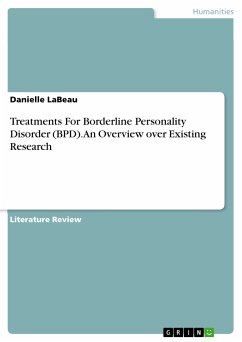Literature Review from the year 2016 in the subject Psychology - Clinical Psychology, Psychopathology, Prevention, grade: A, , language: English, abstract: Borderline Personality Disorder (BPD) is a complicated psychological disorder that is more common than many believe, and involves irregular emotion and behavior and a severe lack in mental awareness/reasoning. Due to the vast and acute diagnostic criteria of BPD, patients are viewed as difficult to treat. To date, there is no medication that has been found to effectively treat BPD. For this reason, many clinicians turn away patients with BPD because they are not competent to treat BPD and the often poor prognosis. Not only are clinicians hesitant to take on a patient with BPD, the patient is often unwilling to seek and maintain treatment. It is thought that those with BPD experienced emotional vulnerability at very young ages, which lead to powerful emotional anguish and pain in their adult years. This pain and distress is often followed by passionate and uncontrollable anger, manipulation, and a desire for attention. BDP can be classified mainly as psychosocial instability, meaning that it takes its form in the inability to maintain relationships. Although there is a desire to be loved and accepted, those with BPD reject others because of their fear of being rejected. In the same way, many people who are in relationships, friends, family, or significant others, cannot handle a person suffering from such a complicated personality disorder. Not only are personal relationships hard to maintain, jobs are also hard for a person with BPD to maintain; this often leads to poverty for those with BPD. All of these factors combined can lead to the abuse of drugs and/or alcohol and eating disorders. Also, because of the deep emotional pain that is present, most of the times BPD patients struggle with self-harm, eventually leading to suicide. It is safe to say that BPD symptoms affect all aspects of life.
Dieser Download kann aus rechtlichen Gründen nur mit Rechnungsadresse in A, B, BG, CY, CZ, D, DK, EW, E, FIN, F, GR, HR, H, IRL, I, LT, L, LR, M, NL, PL, P, R, S, SLO, SK ausgeliefert werden.









